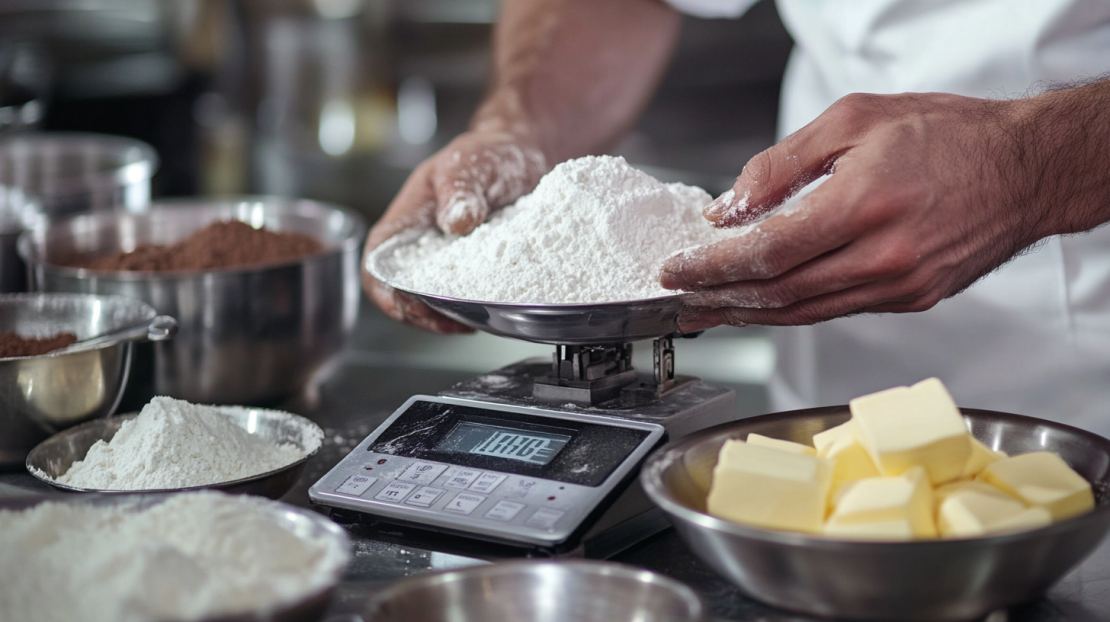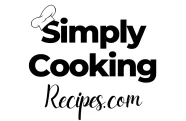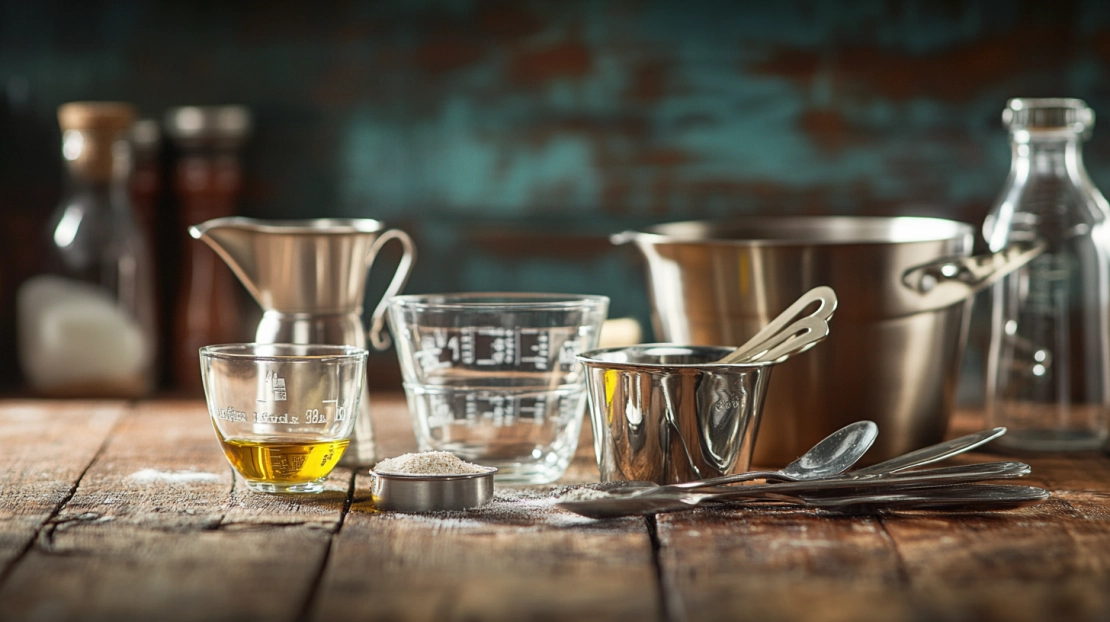Weight vs Volume Measurements in Cooking – Which Should You Use and Why?
Hey there, fellow food enthusiasts! I’m Chef Ryan, and after 20 years of whisking, measuring, and occasionally messing up in professional kitchens, I’m here to tackle a question that’s probably brought you to this article: What’s the deal with weight versus volume measurements in cooking?
Whether you’re scratching your head over a recipe that calls for “225g of flour” when you’re used to cups, or you’re wondering why your grandma’s cookie recipe never turns out quite right, you’re in the right place. Let’s dive into the tasty world of culinary measurements!
- Weight vs Volume Measurements in Cooking – Which Should You Use and Why?
- What is the Difference Between Volume And Weight Measurements In Cooking?
- When Volume Measurements Shine
- The Weighty Advantages of… Well, Weight
- The Great Flour Debate
- When to Use Which Method
- Best Applications of Volume vs Weight Measurements in Cooking
- Making the Switch: Tips for Transitioning to Weight
- Weight To Volume Conversion Guide For Common Cooking Ingredients
- FAQs: Your Burning Questions Answered
What is the Difference Between Volume And Weight Measurements In Cooking?
The main difference between volume and weight in cooking is what they measure:
Volume measures the space an ingredient occupies, using units like cups or tablespoons. It’s easy to visualize but can be inconsistent, especially for dry ingredients like flour that can compress.
Weight measures the mass of an ingredient, using units like grams or ounces. It’s more precise and consistent, regardless of how an ingredient is packed or settled.
In practical terms:
- Volume is often used for liquids and in casual cooking
- Weight is preferred for baking and precise recipes, ensuring consistent results
Using weight typically leads to more accurate and reproducible results, particularly in baking where precise ratios are crucial.
When Volume Measurements Shine
Let’s give volume its due. There are times when measuring by volume is perfectly fine:
- Liquids: Measuring a cup of milk or a tablespoon of oil? Volume’s got you covered. Liquids have a consistent density, so a cup is a cup is a cup.
- Small amounts: Need a teaspoon of vanilla extract or a pinch of salt? Whip out those measuring spoons. For tiny amounts, the difference between weight and volume is negligible.
- Quick, everyday cooking: Throwing together a stir-fry or a soup? Unless you’re following a super precise recipe, eyeballing a cup of chopped veggies is usually good enough.
The Weighty Advantages of… Well, Weight

Now, here’s where things get interesting. For many ingredients, especially in baking, weight measurements have some serious advantages:
- Accuracy: A cup of flour can weigh anywhere from 120 to 160 grams, depending on how you scoop it. But 130 grams of flour is always 130 grams. This precision is crucial in baking, where the ratio of ingredients can make or break your cake.
- Consistency: Ever wonder why your grandma’s cookie recipe never turns out the same twice? If she measured flour by volume, that could be why. Weight measurements give you consistent results every time.
- Ease of scaling: Want to halve or double a recipe? With weight measurements, it’s simple math. Half of 250 grams is 125 grams. Half of 2 1/3 cups? Uh… let me get back to you on that.
- Less mess: Measuring flour by weight? Just pour it into the bowl on the scale. No need to level off a cup and get flour all over your counter.
- International recipes: Most countries outside the US use weight measurements. If you’re trying that amazing British scone recipe, weighing your ingredients will be much easier than converting from grams to cups.
The Great Flour Debate
Let’s talk about flour for a minute, because it’s the poster child for why weight matters. I once did an experiment with my culinary students:
- Scooping flour straight from the bag: 160g per cup
- Spooning flour into the cup and leveling: 120g per cup
- My next-door neighbor Barb’s “heaping cup” method: a whopping 180g!
That’s a difference of up to 60 grams per cup. In a recipe that calls for 3 cups of flour, you could be off by 180 grams – that’s more than an entire extra cup! No wonder your bread is coming out dense and heavy.
When to Use Which Method
Okay, so when should you use volume, and when should you weigh?
Use volume for:
- Liquids
- Small amounts of ingredients (less than a tablespoon)
- Casual, everyday cooking where precision isn’t crucial
Use weight for:
- Flour, sugar, and other dry goods in baking
- Any recipe where precise ratios matter (bread, pastries, candies)
- When scaling recipes up or down
- When following recipes from outside the US
Best Applications of Volume vs Weight Measurements in Cooking
| Measurement Type | Best Application | Example Ingredients |
|---|---|---|
| Volume (cups, tablespoons, teaspoons) | Liquids | Water, milk, cream, oil, broth, juice, vinegar, soy sauce, coconut milk, maple syrup, coffee, wine, lemon juice |
| Small Quantities | Salt, baking powder, baking soda, spices, vanilla extract, honey, mustard, chili flakes, pepper, garlic powder, cinnamon, cayenne pepper | |
| Everyday Cooking | Chopped vegetables, diced fruits, sauces, soups, stews, marinades, salad dressings, pesto, salsa, purees, cream-based sauces, smoothies | |
| Weight (grams, ounces) | Baking | Flour, sugar, butter, chocolate, cocoa powder, yeast, eggs, nuts, oats, cream cheese, bread flour, sourdough starter, almond flour, dried fruits |
| Scaling Recipes | Flour, sugar, butter, eggs, cream, chocolate chips, nuts, breadcrumbs, oats, shredded cheese, ground beef, lentils, beans | |
| International Recipes | Metric recipes for bread, pastries, cakes, dough, macarons, crêpes, pasta dough, tarts, meringue, biscuits, French pastries, Italian desserts |
Making the Switch: Tips for Transitioning to Weight
Ready to give weight measurements a try? Here are some tips:
- Invest in a digital kitchen scale: They’re not expensive, and they’ll revolutionize your baking. Look for one that can switch between grams and ounces.
- Start with baking recipes: This is where you’ll see the biggest difference in your results.
- Create a conversion chart: As you use recipes, note down the weight equivalents of volume measurements. Soon you’ll have a personalized cheat sheet.
- Don’t stress about small amounts: It’s okay to use teaspoons and tablespoons for small quantities.
- Practice: Like any new skill, it might feel awkward at first. Stick with it, and soon it’ll be second nature.
Weight To Volume Conversion Guide For Common Cooking Ingredients
| Ingredient | Volume | Weight (grams) |
|---|---|---|
| Dry Ingredients | ||
| All-Purpose Flour | 1 cup | 120g |
| Whole Wheat Flour | 1 cup | 130g |
| Granulated Sugar | 1 cup | 200g |
| Brown Sugar (packed) | 1 cup | 220g |
| Powdered Sugar | 1 cup | 120g |
| Cocoa Powder | 1 cup | 100g |
| Almond Flour | 1 cup | 96g |
| Liquid Ingredients | ||
| Milk | 1 cup | 240g |
| Water | 1 cup | 240g |
| Honey | 1 cup | 340g |
| Olive Oil | 1 cup | 216g |
| Butter (melted) | 1 cup | 227g |
| Spices and Small Quantities | ||
| Baking Powder | 1 tsp | 4g |
| Salt | 1 tsp | 6g |
| Ground Cinnamon | 1 tsp | 2.6g |
| Vanilla Extract | 1 tsp | 4.2g |
Incredibly Helpful Conversion Charts
Metric to Imperial Liquid Measurements
| Metric Volume | Imperial Volume |
|---|---|
| 5 ml | 1 tsp |
| 15 ml | 1 tbsp |
| 30 ml | 1 fl oz |
| 100 ml | 3.4 fl oz |
| 240 ml | 1 US cup |
| 500 ml | 2.1 US cups |
| 1 liter | 4.23 US cups |
| 1 liter | 33.8 fl oz |
| 1 liter | 1.06 quarts |
| 1 liter | 0.26 gallons |
Here is a link to a very handy liquid volume converter.
Common Baking Ingredient Conversions
| Ingredient | Metric Volume | Imperial Volume | Metric Weight | Imperial Weight |
|---|---|---|---|---|
| Flour | 240 ml | 1 US cup | 120 g | 4.25 oz |
| Granulated Sugar | 240 ml | 1 US cup | 200 g | 7 oz |
| Brown Sugar | 240 ml | 1 US cup | 220 g | 7.75 oz |
| Butter | – | 1 US cup | 227 g | 8 oz |
| Cocoa Powder | 240 ml | 1 US cup | 100 g | 3.5 oz |
| Honey | 240 ml | 1 US cup | 340 g | 12 oz |
| Milk | 240 ml | 1 US cup | 240 g | 8 oz |
| Oil | 240 ml | 1 US cup | 220 g | 7.75 oz |
Check out this handy baking ingredient conversion calculator.
Quick Reference for Teaspoons, Tablespoons, and Cups
| Teaspoons | Tablespoons | Imperial Volume | Metric Volume |
|---|---|---|---|
| 3 tsp | 1 tbsp | 0.5 fl oz | 15 ml |
| 6 tsp | 2 tbsp | 1 fl oz | 30 ml |
| 12 tsp | 4 tbsp | 2 fl oz | 60 ml |
| 16 tsp | 5.33 tbsp | 2.67 fl oz | 80 ml |
| 24 tsp | 8 tbsp | 4 fl oz | 120 ml |
| 48 tsp | 16 tbsp | 8 fl oz | 240 ml |
| 96 tsp | 32 tbsp | 16 fl oz | 480 ml |
| 192 tsp | 64 tbsp | 32 fl oz | 960 ml |
Calculator for grams to teaspoons
FAQs: Your Burning Questions Answered
Not at all! Keep them for measuring liquids and for recipes where precise measurements aren’t crucial.
I like the OXO Good Grips Digital Scale. It’s durable, accurate, and has a pull-out display for easy reading.
Absolutely! Start by weighing your ingredients as you measure them volumetrically. Over time, you’ll create your own conversion chart.
The main one is that you need a scale. Also, some people find it less intuitive at first. But the benefits usually outweigh these minor drawbacks.
For small amounts like spices, volume measurements are usually fine. The difference is minimal for such small quantities.
Remember, cooking is as much art as science. While precise measurements can elevate your baking game, don’t let it take the joy out of cooking. Happy measuring, and even happier eating!
Disclosure: This article uses automation for structure, but all insights and advice are provided by Ryan Yates, an experienced executive chef with over 20 years of expertise. Additionally, this post may contain affiliate links, which means we may earn a small commission if you purchase through them, at no extra cost to you. This helps support our work and allows us to keep providing high-quality content.


